GV’s Simple Recipe For Getting Started On Your Brand
Warning: This is a post about branding, but I’m no brand expert. For most of my career, any mention of the word brand made me uncomfortable. I figured it was a fine line between “brand exercise” and “total waste of time.”
I was forced to confront my branding heebie-jeebies five years ago, when I joined Google Ventures. Previously, I’d always worked at big companies (Google, Microsoft, Oakley) with established brands. But at GV, I found myself working with startups who were thinking about their brands for the first time. They were designing logos, creating visual identities, and naming their companies — in other words, making a lot of big decisions.
Brand exercises make big decisions easier
Luckily for our startups, two of my colleagues at GV, Laura Melahn and Daniel Burka, actually are experts on branding. (They’re modest and will tell you they’re not experts, but don’t listen. Among other things, Laura helped name Calico and Daniel helped design the Firefox logo. They really get this stuff.)
Over the past few years, I’ve watched Laura and Daniel help startups through these stressful decisions about naming, identity, logos, and so on. They start with brand exercises. Much to my surprise, the exercises are not a goofy waste of time.
The point of these exercises, it turns out, is to make the abstract idea of “our brand” into something concrete. After doing the exercises, the team gets a common language to describe what their company is about — and all subsequent squishy decisions about visuals, voice, and identity become way easier.
Introducing the Brand Sprint
At GV, we use our five-day Design Sprint to help teams tackle product and marketing challenges. We decided to put the brand exercises into a sprint-like process that any team can use. And the best part is: We squeezed it into just three hours. We don’t think more time necessarily yields better results. And because the process is fast, you can involve the people who really need to be there.
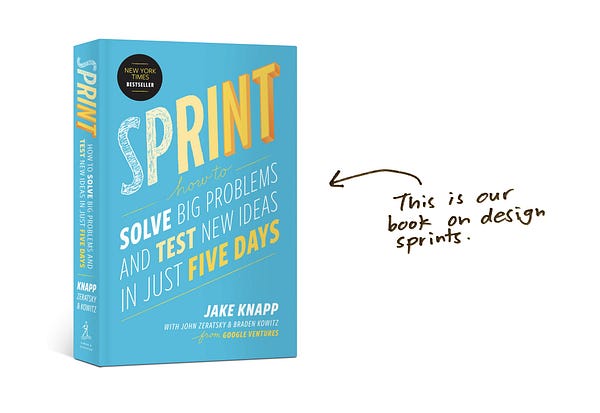 Now, to be clear, we didn’t invent these ideas or exercises. Instead, the Brand Sprint borrows from great thinkers about branding. Laura’s favorite examples include Steve Jobs’s 1997 internal meeting at Apple, Stewart Butterfield’s essay We Don’t Sell Saddles Here, Simon Sinek’s TED talk How Great Leaders Inspire Action, Phil Knight’s Nike memoir Shoe Dog, and the work of the excellent identity agency Hello Monday. If these materials are the greatest hits, the Brand Sprint is our mix tape.
Now, to be clear, we didn’t invent these ideas or exercises. Instead, the Brand Sprint borrows from great thinkers about branding. Laura’s favorite examples include Steve Jobs’s 1997 internal meeting at Apple, Stewart Butterfield’s essay We Don’t Sell Saddles Here, Simon Sinek’s TED talk How Great Leaders Inspire Action, Phil Knight’s Nike memoir Shoe Dog, and the work of the excellent identity agency Hello Monday. If these materials are the greatest hits, the Brand Sprint is our mix tape.
The Brand Sprint consists of six exercises. First, you’ll think about your company’s motivation:
- 20-Year Roadmap helps you think long-term.
- What, How, Why reminds you why your company exists.
Next, you’ll add detail:
- Top 3 Values makes your why more specific.
- Top 3 Audiences helps you prioritize the target for your brand.
Finally, you’ll position your brand relative to others:
- Personality Sliders defines the attitude and style of your brand.
- Competitive Landscape compares your brand to other companies.
This post is a D.I.Y. guide. You can do these exercises with your own team, without any special expertise. At the end, you’ll have a set of diagrams — a simple brand cheat-sheet — that you can use to make decisions. It’s not a replacement for a good branding agency, but it’s a heckuva lot better than nothing. And if you do hire an agency, the cheat-sheet will make you a better, smarter client.
Before you start your Brand Sprint, you’ll need to make sure a few things are in order.
Set the Stage
It’s time to assemble a team, find a three-hour block on the calendar, set the ground rules, and assign some optional homework (which is the best kind of homework). But first, should you even run a Brand Sprint at all?
Start with a trigger
A word of caution: Don’t run a Brand Sprint unless you really have to. If you won’t use the results right away, wait for a trigger event. Good triggers are naming your company, designing a logo, hiring an agency, or writing a manifesto.
Get the right team
You need two to six participants for a Brand Sprint. These have to be company executives. Many startup teams don’t think of themselves as “executives.” If it sounds funny to you, try “decision-maker” or “stakeholder”. Bottom line: Your Brand Sprint needs to include people with authority and ownership of your company’s identity.
Must have in the room:
- CEO
And at least one of these:
- Co-founder
- Head of marketing
- Head of product or design
One participant must be the “Decider” — the company’s true decision-maker about your brand. In most cases, the Decider is the CEO, but in some cases the Decider could be a co-founder or CMO. This does not work without the Decider. Find some way to fit the Brand Sprint into her schedule. If she won’t make the time, don’t do the sprint.
In addition to your executives, you’ll need one or two facilitators. These might be folks from marketing, product, or design. Since you’re reading this post, you’re a good candidate. The facilitators should have good writing skills. (You’ll see why later in the post.)
Sometimes, you might bring in a customer expert. For example, in our Brand Sprint with Element Science, we had CEO Uday Kumar (the Decider) and design director Maarten Dinger — but Uday also brought along his colleague John White, an expert in the medical device field who could help us see through the eyes of the customer.
Schedule a Block of Time
The Brand Sprint is designed to fit into a morning or afternoon. The schedule will go something like this:
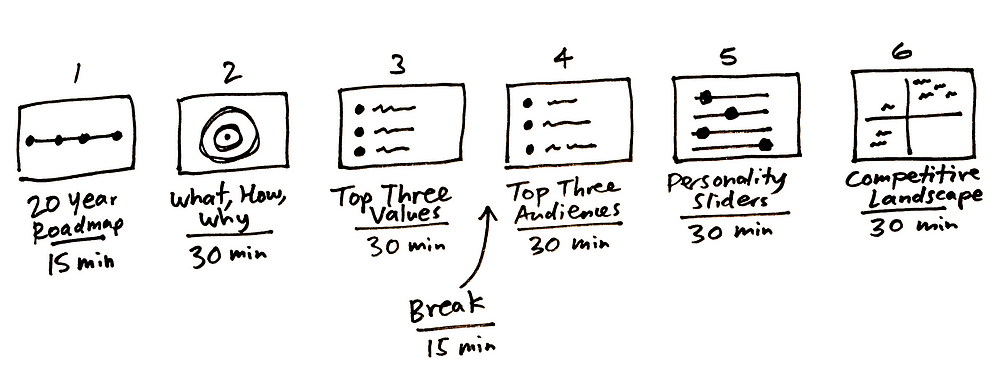
Try to find a block of three straight hours — it works much better if you don’t have to split up and regroup later. Be sure to book your time in a room with lots of whiteboard space, and bring blank white copy paper and some pens.
Homework (optional)
For an optimal Brand Sprint, ask everyone to do two things before you start:
- Read this post.
- Fill out this PDF.
But if you don’t have time before the sprint, don’t worry — it’ll still work.
Set the ground rules
Once everybody’s together in the room, the Brand Sprint has two simple rules to maintain focus:
- No devices. Put away your laptops, phones, Oculus Rifts, etc. (But do take a break in the middle for snacks and email.)
- Time-box all activities with a Time Timer or other simple timer.
Okay, you’ve got a triggering event, you’ve got the right people together, you’ve set the ground rules, and you’ve (maybe) done some homework. You’re ready to sprint!
1. 20-Year Roadmap (15 minutes)

Most teams focus on what they’re doing now, which makes sense. But if your company is successful, your brand will last a long time. So for the first exercise, you’ll look into the future and think about what your company might be doing 20 years from now.
HOW TO
Draw a timeline on the whiteboard, labeled with 5, 10, 15, and 20 years into the future, like this:

What will your company be doing at each of those future dates? To decide, you’ll use a simple exercise we call Note-and-Vote. In fact, you’ll be using Note-and-Vote throughout the Brand Sprint, because, as Daniel Burka says, “If you let people talk out loud very much, the whole thing will be a disaster.”
Note-and-Vote speeds up thinking and decision-making by alternating between solo and group activities. Here’s how it works for the 20-Year Roadmap:
1. Each person quietly writes down his or her own prediction for all four dates.
2. Going around the room, each person reads their answers aloud and the facilitator writes them on the whiteboard.
3. No argument or discussion yet.
4. Each person looks at the list and quietly writes down their favorite answers.
5. Going around the room, each person reads their votes aloud and the facilitator marks the votes on the whiteboard.
6. Discuss and argue for about five minutes (use a timer to keep it to five minutes!).
7. The Decider chooses her favorite item for each future date.
8. Take a photo of the whiteboard and put it into a new slide deck called “Super Simple Brand Guide”.
You might be wondering: Who cares? What’s the point of imagining what we’ll be doing 20 years from now?
Nobody will expect you to stick to the 20-Year Roadmap—that’s not the point. The point of the 20-Year Roadmap is to get your team thinking about the lifetime of your brand. A great brand will last until the year 2038 — and beyond.
2. What, How, Why (30 minutes)

What, How, Why is an exercise based completely on Simon Sinek’s “Golden Circle”. (Sidenote: Sinek’s TED talk is the third most popular of all time with 30 million views, despite grainy video and the fact he uses a flimsy flipchart instead of fancy-pants slides. It wasn’t even at the main TED — it was at a small TEDx event! But the framework and the talk are so great it doesn’t matter.)
This freakin’ Office Depot flip chart has 30 million views.
Sinek’s premise is basically this: You need to know why you’re in business — and talk about it. When a company has a strong motivation and that motivation shines through, customers buy the product. It’s easy to find supporting examples. Sinek points to Apple, but companies like Nike, Patagonia, Airbnb, and LEGO obviously fit the bill.
On the other hand, you might argue, there are plenty of successful companies whose primary motivation seems to just be… making money. And, yeah, that’s a reasonable argument. But if you’re reading this post, you probably want a brand that stands out from the competition, and stands for more than just financial success. And I think Sinek’s right: why brands are stronger.
Plus, knowing why you’re in business can be very motivating for you and your team. In other words, it’s worth the 30 minutes.
HOW TO
Start by drawing three concentric circles on a whiteboard. Label the outside circle “what”, the middle circle “how”, and the inside circle “why”, like this:
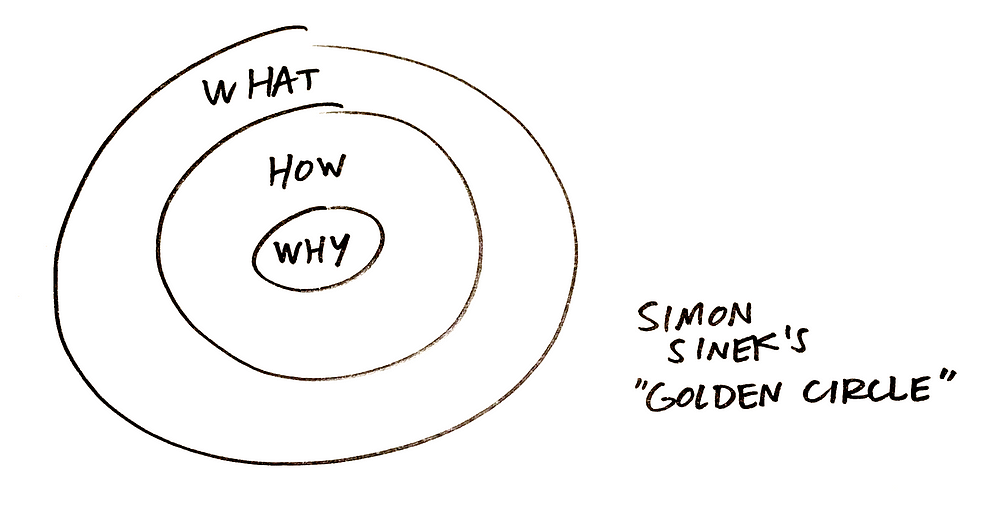
Next, collect answers to these questions:
What does your company do?
A phrase or sentence describing your primary business for the next five years. Examples: “Make toothpaste”, “fix cars”, etc.
How do you do it?
What’s your secret sauce? What technology or approach sets you apart from the competition? Examples: “Made with all-natural ingredients”, “best-in-class friendly service”, etc.
Why?
You can think of the why as the reason you get out of bed in the morning and go to work. The why should reflect the core reason your company exists, and it won’t change much over time. You may pivot the business, launch new products, and enter new markets, but your why remains the same. Examples: “Promote healthy living”, “help people get where they need to go”, etc.
Once again, you’ll Note-and-Vote:
1. Each person quietly writes down his or her ideas for what, how, and why.
2. Going around the room, each person reads their answers aloud and the facilitator writes them on the whiteboard.
3. No argument or discussion yet.
4. Each person looks at the list and quietly writes down their favorite answers.
5. Going around the room, each person reads their votes aloud and the facilitator marks the votes on the whiteboard.
6. Discuss what and how for about five minutes each, but don’t argue the semantics — it’s not that important.
7. At the end of each five-minute segment, the Decider chooses her favorite answer.
8. Discuss why for about ten minutes. This can be difficult, so agree that today’s version will be a placeholder — you can come back to it later.
9. After ten minutes, the Decider makes the call.
10. Take a photo of the whiteboard and add it to your slide deck.
To better understand the power of why, let’s talk about Apple and Nike.
As I mentioned above, Simon Sinek uses Apple as an example of a company who understands and communicates their why extremely well. Normally, I avoid using Apple or Steve Jobs as an example for anything, because (a) it’s really overdone and (b) there are so many hard-to-replicate reasons for their success. Saying “do what Apple did!” isn’t very helpful advice. But… when Laura showed me this 1997 video of Jobs, I realized we had to include it in this guide.
I don’t know, maybe this guy knows something about brand. Let’s hear him out.
The video is worth watching for a few reasons. First, it’s unpolished. Jobs was a fantastic speaker, and here you get to see him without the trappings of an iPhone event. Second, he’s addressing Apple employees, not the world. It’s a behind-the-scenes video from before Apple’s resurgence, which is very cool to see. And finally, it’s completely on-topic for your Brand Sprint. This is the moment where Jobs explains Apple’s why and its importance to their products, advertising, and sales. Today — 20 years later! — the why is still relevant.
One more classic example is Nike. (Also a bit obvious and overdone, but so good I can’t resist.) Here’s a quote from Phil Knight’s Shoe Dog about the earliest days of Nike, in 1964:
“I’d been unable to sell encyclopedias, and I’d despised it to boot. I’d been slightly better at selling mutual funds, but I’d felt dead inside. So why was selling shoes so different? Because, I realized, it wasn’t selling. I believed in running. I believed that if people got out and ran a few miles every day, the world would be a better place, and I believed these shoes were better to run in. People, sensing my belief, wanted some of that belief for themselves. Belief, I decided. Belief is irresistible.”
Today, more than 50 years later, Nike stands for pretty much the exact same thing. Here’s their current mission statement:
Bring inspiration and innovation to every athlete* in the world.
*If you have a body, you are an athlete.
Coming up with a great why sounds basic. It’s not. It’s surprisingly hard. Encourage your CEO or founder to be idealistic and remember why they started this company or took this job. We spend most of our time at the office being pragmatic. This is not a time to be pragmatic — it’s a time to wear your heart on your sleeve.
3. Top Three Values (30 minutes)

Next, you’ll make your why more specific by listing and ranking your company values. I know “company values” sounds like consultant baloney, but it’s just another way of saying “stuff that really matters to us” or, better yet, “decision-making principles”.
Company values are often things like:
- Honesty
- Integrity
- Sustainable
- Affordable
- Luxury
- Data-driven
- Service
- Simple
- Trusted
- Reliable
- Accessible to everyone
- Etc.
Lots of companies list their values, but very few do the hard work to reduce and prioritize. And prioritization is essential — you’ve got to cut down to just three values and rank them so you have one single most important value. If you have ten or twenty values, anything you do can be considered “on brand”. Knowing your most important value makes decisions easier, clarifies your message, and sets you apart from the competition. It’s hard work but worth it.
HOW TO
To generate and rank your values, you’ll do another Note-and-Vote:
1. Each person quietly writes down a list of values—as many as they can think of.
2. Going around the room, each person reads their values aloud and the facilitator writes them on the whiteboard in one giant list.
3. No argument or discussion yet.
4. Each person looks at the list and quietly writes down the three values they think best describe the company.
5. Going around the room, each person reads their votes aloud and the facilitator marks the votes on the whiteboard.
6. Discuss for about five minutes.
7. At the end of five minutes, the Decider makes the call. Give her a few minutes to quietly write down her top three values, in order. This is the hard part, but it’s also the key to success—you must narrow down to three, and most importantly, you must choose a single most important value.
8. The Facilitator writes the final decision on the whiteboard.
9. Take a photo of the whiteboard and add it to the slide deck.
4. Top Three Audiences (30 minutes)

Values are helpful for brand decisions, but they’re not the whole picture — you need to know who you’re talking to. In this exercise, you’ll list all your possible audiences, then figure out who’s most important.
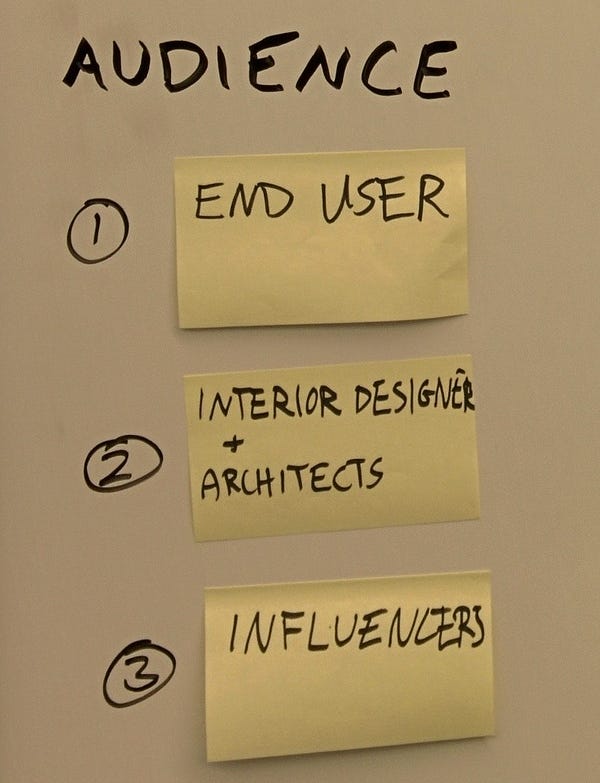
Who qualifies as an “audience”? Customers, for sure, but you can think more broadly by asking this question: Whose opinion do you care about?
When you answer that, you may realize your brand matters not just to customers but also to other businesses, reporters, advertisers, employees, potential hires, and heck, maybe even government regulators.
A common question is whether to use broad categories (like “athletes”) or segments (like “runners”). Really it’s up to you — most companies just know whether segments or categories are the best way to go.
HOW TO
Guess what, Note-and-Vote!
1. Each person quietly writes down their own list of the company’s audiences.
2. Going around the room, each person reads their list aloud and the facilitator writes one giant list on the whiteboard.
3. No argument or discussion yet.
4. Each person looks at the list and quietly writes down the two audiences they believe are most important.
5. Going around the room, each person reads their votes aloud and the facilitator marks the votes on the whiteboard.
6. Discuss for about five minutes.
7. At the end of five minutes, the Decider makes the call. Give her a few minutes to quietly write down her top three audiences, in order.
8. The Facilitator writes the final decision on the whiteboard.
9. Take a photo of the whiteboard and add it to the slide deck.
Okay, at this point you’ve talked through the company’s identity and its audience. Only two more activities to go!
These final two exercises are classics you may have seen before. Both are designed to get you thinking about how your company’s brand compares with others. And, to be honest, both exercises may seem corny the first time you do them. Just power through — I promise this is all worthwhile.
5. Personality Sliders (30 minutes)

“Personality Sliders” sounds delicious, but it’s really just another whiteboard thing. In this exercise, you’ll position your company’s “sliders” between pairs of brand extremes:
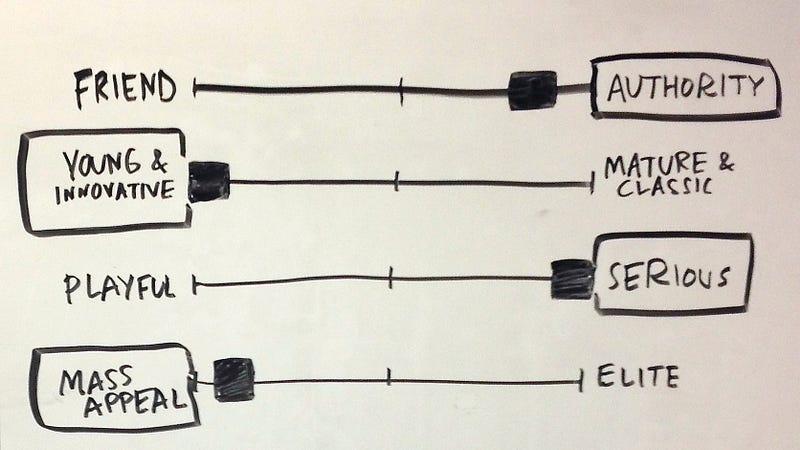
There are good reasons to be on the left or right of any of these lines, and it’s even okay if some of your sliders end up in the middle. But it’s helpful to be strongly opinionated on at least one or two ranges.
HOW TO
1. Draw a diagram on the whiteboard with four ranges:
- “Friend” to “Authority”
- “Young & Innovative” to “Mature & Classic”
- “Playful” to “Serious”
- “Mass Appeal” to “Elite”
2. Give everyone a printout of this diagram (PDF here):
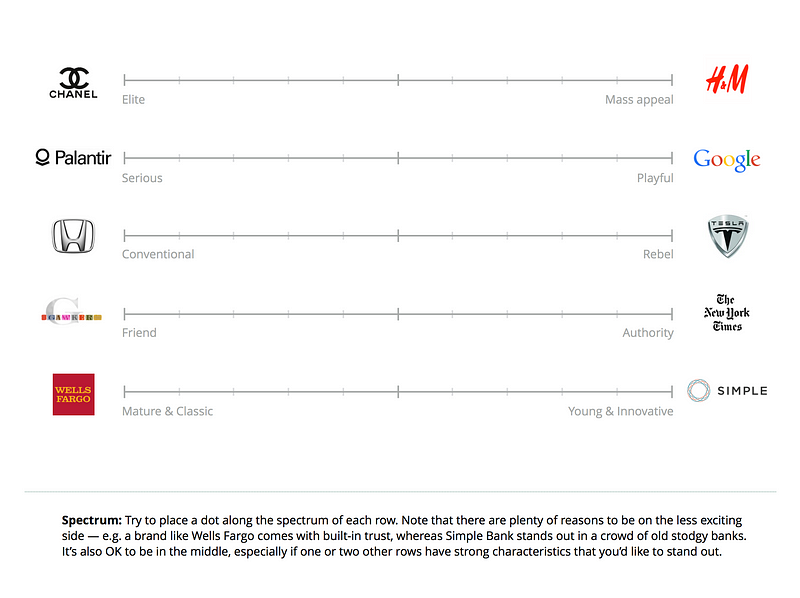
3. Each person marks their printout to indicate where they think the company sits on each range.
4. Everyone takes turns marking the whiteboard with their sliders, then labeling each one with their initials.
5. Discuss any diagram where people disagree about where the company should be. For example, if Andy put a dot right by “Mass Appeal” and Beatrice put a dot right by “Elite”, they should explain their positions. Time this discussion—it needn’t take longer than five to ten minutes.
6. At the end of the discussion, the Decider makes the call. She should be given a few minutes to quietly plot her final choices on the whiteboard.
7. Take a photo of the whiteboard and add it to the slide deck.
6. Competitive Landscape (30 minutes)

This last exercise is a simple 2×2 matrix (I know, consultant nirvana). I actually don’t think I even need to explain this one, so let’s dive right in:
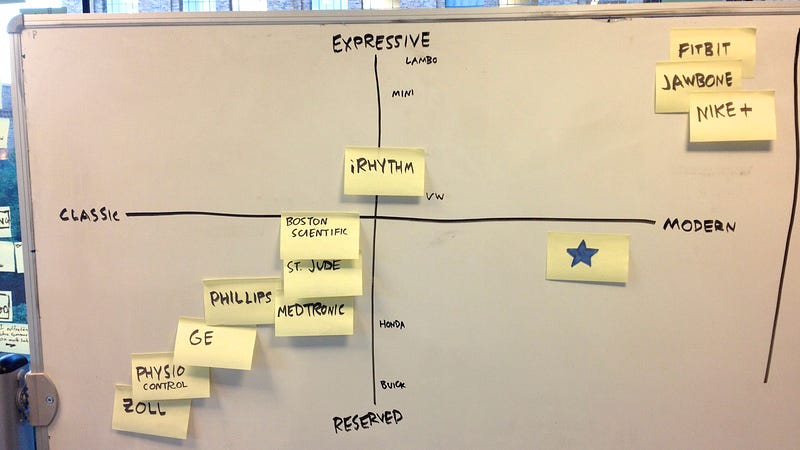
HOW TO
1. Draw a 2×2 matrix:
a. “Classic” to “Modern” on the x-axis
b. “Expressive” to “Reserved” on the y-axis
2. Each person writes down a list of other companies in the same space or industry.
3. Each person chooses the one or two most important companies on their list.
4. Going around the room, each person reads their choices aloud and the facilitator writes the company names on sticky notes (one name per sticky).
5. One at a time, place the sticky notes on the matrix. Quickly discuss where it should go. Repeat.
6. Once all the sticky notes are up, the facilitator should ask the Decider if she’d like to move any of the notes.
7. Finally, plot your own company on the matrix. This should be fairly easy — after all, you’ve just been doing brand exercises for 150 minutes.
8. Double-check: Look back at the rest of the sprint exercises. Does this placement make sense for your 20-Year Roadmap, What How Why, Values, Audience, and Brand Sliders?
9. As always, the Decider makes the final call.
10. Take a photo of this whiteboard and add it to the slide deck.
Now you have a complete Super Simple Brand Guide! That’s right — it’s just a slide deck filled with whiteboard photos. But don’t underestimate it.
Taken together, these six diagrams are a powerful, concrete representation of your company’s brand. When you’re faced with a big decision — about naming, identity, marketing, or even company policy — you can use these diagrams as a guide. And if you decide to hire an agency, you can start your relationship with them by walking through your new brand guide. It’ll give you a giant head start.
Your Super Simple Brand Guide can also help new employees understand what your company is about, and can even remind the founding team what you stand for. That’s a big deal. When you really nail your brand, it’s not a fluffy veneer applied at the end (as I had often feared). Instead, it’s everything: what you build, the way you build it, who you build it for, and how you do your work. And we think it’s definitely worth three hours to figure that out. 🙂
–
Super deluxe thanks to Laura Melahn, Daniel Burka, and John Zeratsky
This article first appeared in www.library.gv.com
Seeking to build and grow your brand using the force of consumer insight, strategic foresight, creative disruption and technology prowess? Talk to us at +9714 3867728 or mail: info@groupisd.com or visit www.groupisd.com


